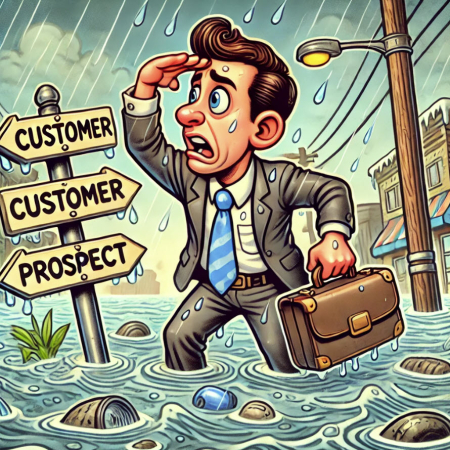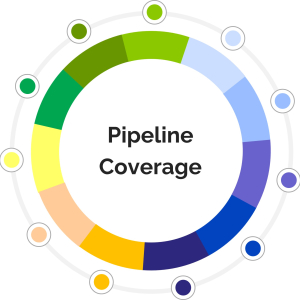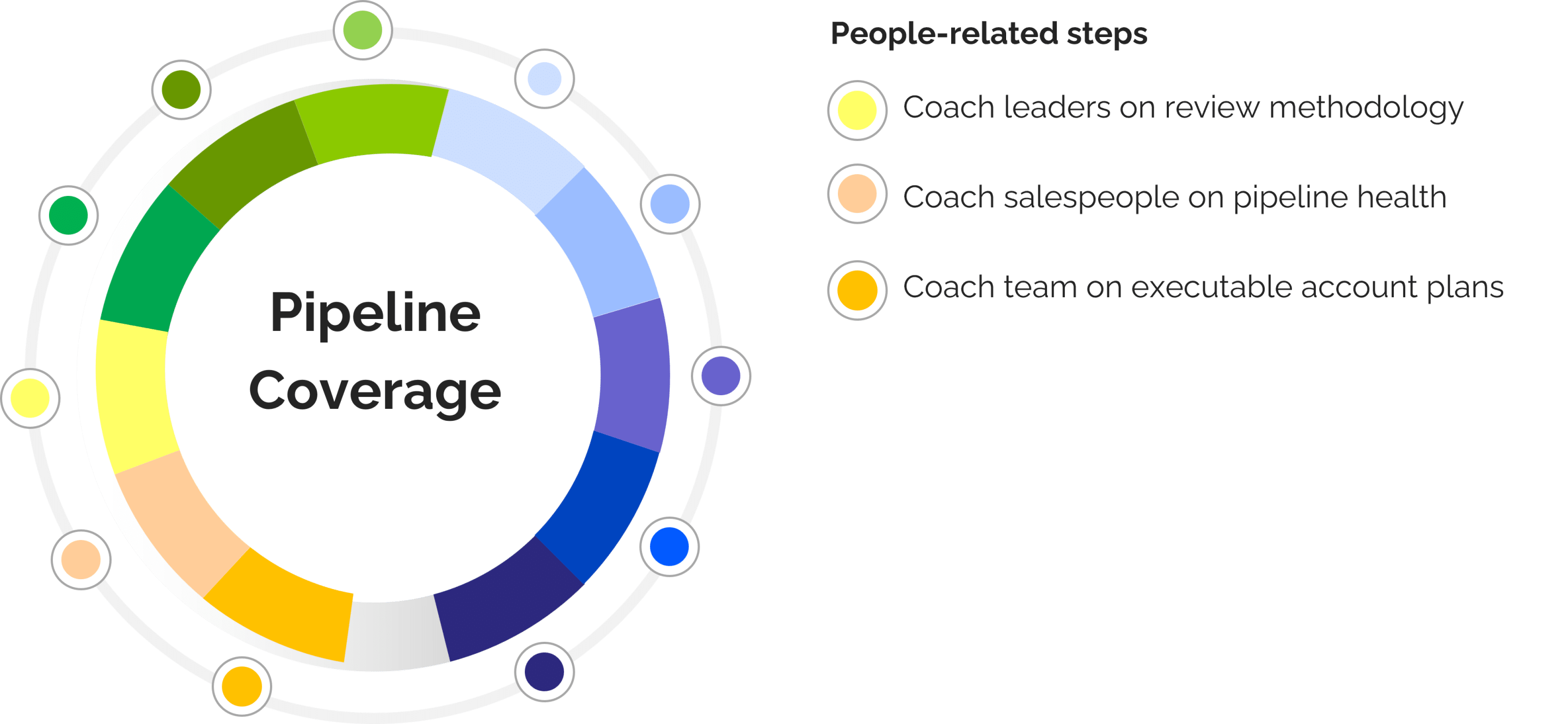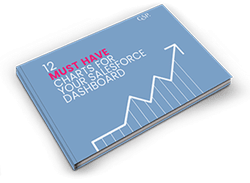The Myth About 3x Pipeline Coverage—and What to Do Instead
The 3x Pipeline Coverage Rule is Flawed. This is How High-Performing Teams do it Differently to Secure Strong Funnel Coverage.
Last updated December 19, 2025
“If I Have 3x Pipeline Coverage, Will I Hit My Sales Target?”
In many businesses, 3x pipeline coverage is a compelling goal – get your sales pipeline to three times your quota, and you'll be on track to meet your target. However, 3x pipeline coverage is a flawed concept that provides no guarantee of hitting your sales target.
In fact, aiming for 3x pipeline coverage is simplistic, often leading to missed sales quotas and unreliable revenue forecasts.
Instead, a smarter approach is to use weighted funnel coverage, as it provides a clearer picture of pipeline health and the likely sales outcome. With this approach, forecasts become more realistic, and your team is more likely to consistently meet sales targets.
In this guide, I'll go beneath the seductive simplicity of 3x pipeline coverage and show you a more practical approach to quantifying expected revenue.
The best bit?
I'll explain the steps you can take today to implement a more robust and reliable method for measuring funnel coverage in your business.
In short, if you are looking for an alternative to 3x pipeline coverage and want to know whether you have sufficient funnel coverage to hit your number, you're in the right place.
Let's begin.
What is the 3x Pipeline Coverage Rule in Sales?
In a nutshell, the 3x pipeline coverage rule answers the big question, “If I have 3x pipeline coverage, will I hit my sales target?” The calculation divides the open pipeline due to close by the sales target for the same period to give a funnel coverage ratio.
The approach is often referred to as ‘3x pipeline coverage,’ because traditionally, the rule of thumb is that your funnel coverage within a period should be three times bigger than your target.
For example, if your monthly quota is $100,000, you need $300,000 of pipeline to hit your target.
Of course, some businesses believe that 4x pipeline coverage – or even 5x pipeline coverage – is a better measure of adequate funnel coverage (so in this example, $400,000 or $500,000). It's the same principle, but for consistency, I'll refer to 3x pipeline coverage throughout this article.
3x pipeline coverage is a seductive concept. It's straightforward, easy to understand, and, on the face of it, a reasonable way to assess whether you have enough funnel coverage to hit your sales goal.
Nevertheless, businesses that rely on this method to calculate funnel coverage and achieve the 3x goal still struggle to understand why they consistently fail to meet their revenue goals. The reason is that the 3x pipeline coverage method is fundamentally flawed.
Let's look at why.
What Makes 3x Pipeline Coverage Wrong?
If you aim to achieve 3x pipeline coverage, you risk overlooking essential factors, such as deal quality, timing, and whether your pipeline is actually accurate. It creates overconfidence and delivers inflated forecasts.
There are four fundamental problems with the concept of 3x pipeline coverage, which we'll explore in more detail in the following sections:
- Not all periods need the same funnel coverage.
- When compared to 3x pipeline coverage, more reliable metrics are readily available.
- Focusing on pipeline coverage size risks overconfidence in hitting your target.
- 3x pipeline coverage is a self-fulfilling goal.
Not All Periods Need the Same Funnel Coverage
Imagine your average sales cycle is 4 months. In a well-managed sales and marketing environment with an average sales cycle of 4 months, all three levels of funnel coverage in the diagram below may be acceptable:
- Current month: only contains well-qualified opportunities at advanced stages in the sales cycle, which are likely to close by the end of the month. As a result, at the start of the month, we don't need 3x pipeline coverage for the current month; instead, 1.3x may be sufficient.
- Month 4: your pipeline contains various deals at a mix of opportunity stages – some are already well-qualified, while salespeople are still validating others. Consequently, 3x pipeline coverage may be a reasonable goal for month four.
- Month 6: if our sales cycle is typically 4 months, we can accept a funnel coverage ratio in month 6 that is significantly less than 3x. It's reasonable to assume that as-yet unidentified leads and opportunities will bolster the funnel.
So that's our first problem with the 3x pipeline coverage approach. Like a stopped clock, it's only an accurate measure of funnel coverage at specific times.
And as you'll see, even then, there are other problems.
When Compared to 3x Pipeline Coverage, More Reliable Metrics are Readily Available
The 3x pipeline coverage method assumes that you will win a third of all deals that are due to close in any given period.
In other words, it applies a top-down weighting of 33% to the pipeline:
However, a bottom-up, weighted funnel coverage summation is statistically more valid. And most CRM systems, including Salesforce, automatically calculate it for you (in Salesforce, the field is 'Expected Revenue'). The calculation is straightforward – it's the sum of the opportunity probability for each deal multiplied by its value.
Applying opportunity probability best practices improves the reliability of your ‘Expected Revenue’ and produces a sales forecast that will stand up to scrutiny. Emerging AI functionality, such as Einstein Prediction Builder, further increases confidence in forecasting the outcome of every pipeline opportunity.
I’ll show you how to incorporate these facilities into your funnel coverage analysis shortly. But for now, let’s agree that more precise metrics are readily available compared to the blunt instrument of top-down weighting.
Pipeline Coverage Size Risks Overconfidence in Hitting Your Target
Overconfidence is a common problem that arises when overlooking pipeline quality. It's also a significant risk for sales managers who appear to have 4x, 5x, or more pipeline coverage, because the metric doesn't account for pipeline quality.
For example, if some deals have slipped multiple times from one month to another, these opportunities represent a higher-than-average risk to your quota.
Moreover, the 3x pipeline coverage rule doesn't differentiate between early-, mid-, and late-stage deals scheduled to close within the period. While everything in the garden may look rosy because it seems there is ample funnel coverage, an over-reliance on low-quality deals is a surefire way to miss your target.
3x Pipeline Coverage is a Self-Fulfilling Goal
Salespeople often manage their funnel coverage to hit the 3x target, sometimes adding enough opportunities with the sole purpose of meeting it – even if those deals are of poor quality or unlikely to close. The problem here is that these low-probability deals make the numbers look good, but they distort the proper picture of your pipeline health.
The result? Waterlogging.
Waterlogging in sales happens when the pipeline contains multiple opportunities that no longer have (or never had) legs. Consequently, sales leaders end up wading around knee-deep in water, desperately looking for a patch of dry land.
In other words, multiple open opportunities have a close date at the end of the quarter or year. However, not many of these opportunities come to fruition. But from a 3x pipeline coverage perspective, everything looks great.
It's not a trap you want to fall into.
What’s the Alternative to 3x Pipeline Coverage?
The alternative to 3x pipeline coverage is to use the ‘Weighted Pipeline’ approach for periods within the foreseeable future (i.e., the length of the sales cycle). Beyond the sales cycle period, recognize that the weighted pipeline is unlikely to exceed quota. Therefore, concentrate on driving new leads and qualified opportunities.
Let’s break it down further into two steps.
Step 1. Use the Weighted Pipeline Approach for Sales Cycle Periods
When reviewing the funnel coverage for periods within the average sales cycle, compare the weighted pipeline to the quota for each period. (The weighted pipeline is the sum of the Amount multiplied by the Probability for each opportunity.)
Some opportunities will close more quickly than the average, and others will take significantly longer. Nevertheless, your pipeline review process should focus primarily on the upcoming months within your average sales cycle.
Your first task is to assess pipeline quality. Key metrics to evaluate pipeline quality include:
- # close date month changes
- # days open
- # days since the last stage change.
Note that these are custom (rather than standard) fields that you can build yourself or obtain through the GSP Target Tracker or GSP Sales Dashboard apps.
Next, compare the weighted pipeline to the quota for each month. Assuming opportunities in the funnel are of good quality, if the weighted pipeline for each month exceeds the target, you can focus on closing the deals you already have.
Conversely, if the quota exceeds the weighted pipeline, you must apply tactical steps to address the shortfall. These steps may include:
- Upgrade or add-on sales to existing customers.
- Conducting one-off marketing campaigns to generate quick deals.
- Considering whether it’s possible to bring forward any deals due to close in later months.
Remember, even within the average sales cycle period, a relatively small shortfall when comparing the weighted pipeline to the target may be acceptable.
For example, month 4 may show a shortfall in the four-month average sales cycle. This position may be acceptable, provided that, based on historical experience, you are confident that deals with a shorter sales cycle will enter the pipeline.
But what about the longer term? In other words, what about the months and quarters beyond your typical sales cycle?
2. Create New Opportunities And Leads for Later Months
Once you've reviewed the funnel coverage for the upcoming months within the average sales cycle, shift your focus back to the long term.
For example, if your average sales cycle is four months, it's reasonable to assume there isn't enough weighted pipeline to meet your revenue targets in later months.
This shortfall will likely exist even if the 3x pipeline coverage approach suggests the funnel is big enough in these months. You should:
- Recognize that 3x pipeline coverage includes unqualified opportunities and some aspirational rather than definable openings.
- Acknowledge your weighted pipeline is unlikely to be adequate for months beyond your sales cycle.
- Focus on creating and executing high-quality key account plans, proactive business development, and marketing activities that will generate new leads and opportunities.
Taking these steps means creating a longer-term, early-stage funnel in which some leads morph into well-qualified opportunities by the time you reach your average sales cycle.
How Do You Implement Alternatives to 3x Pipeline Coverage?
In this blog post so far, I have explained why the 3x pipeline coverage approach is flawed, and that instead, combining a weighted pipeline approach with strategic funnel growth is a significantly more robust and reliable approach to hitting your sales targets.
To implement an alternative to the 3x pipeline coverage approach, you need to take a structured approach by breaking the steps into three categories: technology, process, and people.
Remember, for maximum impact, you should integrate these steps with a broader sales enablement program that addresses the end-to-end sales and marketing revenue cycle.
Building Your Pipeline Coverage Size with Technology-Related Steps
Here are the technology-related steps required to build reliable pipeline coverage metrics.
- Clean up out-of-date opportunities. When I first review the sales pipelines of many clients, I often see that they contain old opportunities with close dates from the past. Some deals will still have legs, but others will likely be dormant. Either way, getting an accurate view of the weighted pipeline is challenging without cleaning up these deals.
- Standardize opportunity stages. No subject causes as much angst during a Salesforce implementation as the question of which opportunity stages to implement. However, having a clearly defined set of stages with unambiguous definitions and clear exit criteria is essential for an accurate projection of the weighted pipeline.
- Use reports and dashboards to compare the weighted pipeline with quota. You can do this in several ways, including building your own reports and dashboards. I also recommend you look at our dedicated app, GSP Target Tracker. It eliminates work for salespeople and provides a comprehensive and robust target reporting solution.
- Implement pipeline quality metrics. For managers, it's challenging to quickly review all the opportunities in a busy pipeline and identify those that warrant skepticism. However, the metrics of # Close Date Month Changes, # Days Open, and # Days Since the Last Stage Change are vital – they enable you to identify deals that need further scrutiny. Have your system administrator quickly build these metrics using Flows or Apex. Alternatively, the metrics, associated reports, and dashboard charts come pre-built as part of GSP Target Tracker.
- Implement account planning within Salesforce. Creating and tracking executable account plans is crucial for generating revenue from both new and existing strategic customers. You can use the Salesforce account planning functionality, or you can use the more comprehensive yet straightforward app that we've built, GSP Account Planner.
Building Your Pipeline Coverage Size with Process-Related Steps
Here are the process-related steps required to build reliable pipeline coverage metrics.
- Hold weekly pipeline reviews. The most successful sales organizations I've worked with have a weekly review of funnel coverage. The sales cycle length doesn't matter; the pipeline reviews happen every week.
- Define your funnel coverage review methodology. The funnel coverage methodology outlines the process by which people conduct the actual reviews. For example, the methodology defines which reports and dashboard charts to use and in what order. It specifies the preparatory activities that salespeople must undertake. It describes the quality metrics that get reviewed and enables leaders to understand what 'good and bad' look like. It ensures a consistent method for recording actions, documenting next steps, and tracking progress.
- Set a key account plan cadence and methodology. This activity is even more critical in many organizations than the pipeline process and methodology. That's because it occurs less frequently and has a lower level of urgency compared to the pipeline review. However, neglect it at your peril—without regularly reviewing account plans, business development initiatives, and marketing campaigns, you are leaving the longer-term pipeline growth to chance.
Building Your Pipeline Coverage Size with People-Related Steps
Here are the people-related steps required to build reliable pipeline coverage metrics.
- Coach leaders on the funnel coverage review methodology. Don't assume business leaders, even those promoted from sales positions, know how to conduct a funnel coverage review. Instead, organize a program of training and coaching that equips leaders with the knowledge and best practices for applying your funnel coverage review methodology. If you conduct reviews via web meetings, I recommend recording these calls and providing private coaching to managers on how to optimize the effectiveness of funnel reviews.
- Coach salespeople on pipeline self-management. No salesperson should attend a funnel coverage review half-prepared (or even not prepared at all). However, you likely need to coach salespeople on your expectations and how to conduct the preparation. As with managers conducting funnel coverage reviews, assuming everyone will automatically know how to do this is a mistake.
- Coach everyone on writing executable account plans. In the long term, coaching leaders and salespeople on creating high-quality key account plans with executable objectives is a highly effective way to achieve your sales targets. That's because most people find it challenging to write excellent account plans, and even when they do, the objectives and actions quickly get forgotten about in the whirlwind of day-to-day activities.
Pipeline Coverage: Commonly Asked Questions
Sandbagging refers to salespeople keeping quiet about deals until the last moment. Often, these deals are not entered into the CRM system, reducing leaders' pipeline coverage visibility. Only when the deal is about to be signed is the opportunity revealed by the salesperson.
Salespeople often do this to avoid management scrutiny on deals, or because they don't want to have to explain why the deal is lost if it doesn't go ahead. Looking like a 'hero' when a deal is brought in at the last minute to help the team hit quota can also be a factor.
Waterlogging is the opposite of sandbagging. Failing to remove dormant deals from the pipeline results in waterlogging because it becomes difficult to identify the legitimate deals that still demand focus and attention. It's sometimes colloquially described as wading around knee-deep in water looking for a patch of dry land.
Tool To Conduct A Pipeline Coverage Review
Wondering about the best tool to conduct a pipeline coverage review? This video demonstrates how to conduct a funnel coverage review using the Sales Manager Dashboard within the GSP Target Tracker app.
Claim Your Free Pipeline Review
If you like what you've read in this article, here are some immediate steps you can take to improve the way you track pipeline coverage in your business.
- Get your free pipeline coverage review: Contact us today by completing the form below to arrange a call to discuss pipeline coverage in your business, with solid pointers and recommendations to help you get started - no strings attached.
Arrange a pipeline coverage conversation
- Take a look at the GSP Target Tracker app. Now that you’ve read this article, you understand why the 3x pipeline coverage is flawed. Take a look at the Target Tracker app to see how it helps you measure pipeline coverage against targets.
- Explore the GSP Account Planning app: To grow the longer-term funnel, proactive key account plans for strategic customers, prospects, and partners are essential. Unfortunately, these plans don't happen by chance. You need a straightforward yet powerful way to create and track these plans in Salesforce. That's what this app gives you. Here's where to check it out:



















